Sunsail 384
Comfort and speed combine for fun cruising
The Sunsail 384 (and its near identical sistership, the Leopard 38) was introduced at last year's U.S. Sailboat Show in Annapolis, Maryland. Built in South Africa by Robertson & Caine, this midsize cruising catamaran combines spacious accommodations, clever interior innovations, impressive performance and very good pricing. 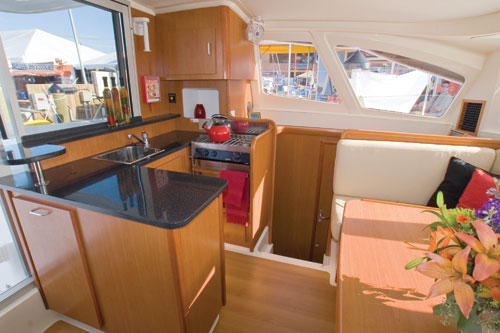
While most charter cats put the design emphasis squarely on space and comfort, designer Gino Morelli was intent on sculpting the 384 hull and keel shapes to generate more speed. By adding a bit of chine to the upper section of the hulls, he was able to reduce wetted surface area in the lower sections. This not only made the boat more slippery but also added interior volume where you want it-at human height. The chines also tend to deflect spray when sailing upwind, thus keeping the deck dry. This review will focus on the Sunsail 384, because that's the boat we sailed. However, the comments and observations also apply to the Leopard 38 as there are very few differences between the two designs.
We had a perfect day to test sail the 384. It was clear, cool and quite breezy. The northwest wind was gusting to 25 knots. Photographer Bob Grieser and I spotted the 384 bobbing in the Chesapeake Bay chop. Grieser eased the photo boat alongside and I hopped aboard. Soon we had the full-batten mainsail up and drawing. We then unfurled the headsail, trimmed up and charged toward the Bay Bridge. Grieser, fiddling with his cameras, had to put the throttles down on the photo boat to catch up with us. 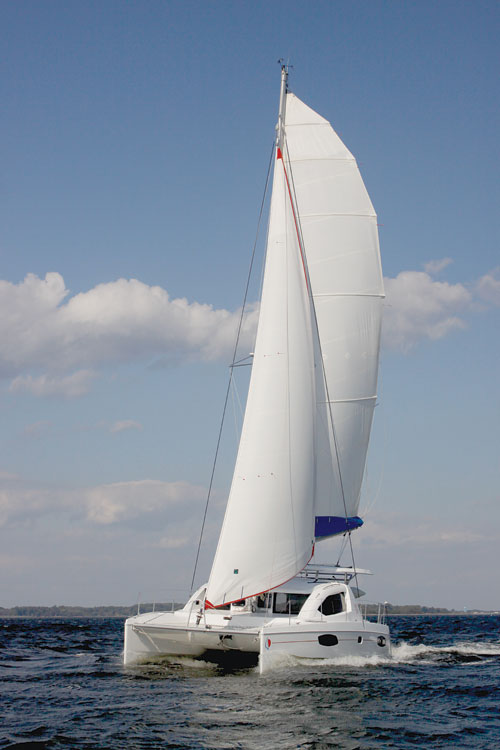
The details
I am impressed by the construction of Robertson & Caine multihulls. The boats feel solid, but the proof is in the sea miles; all of its boats are delivered to North America on their own bottoms. That's right, a 5,000-mile-plus bluewater sea trial. Cruising catamarans must be light and strong and still be able to carry loads. These are not easy boats to build. The 384 hulls and deck are a composite construction, cored with end-grained balsa and E-glass stitched fabrics are used for superior strength and impact resistance. Vacuum bagging ensures a precise glass-to-resin ratio is achieved and limits voids in the layup. Isophthalic gelcoat helps prevent osmosis.
Perched in the incredibly comfortable helm chair I was enjoying the ride. I am not a fan of bulkhead-mounted steering systems, but I must say, as we sped along on a close reach, the 384 handled very nicely. The helm station is the control center of the 384, especially when sailing on port tack because the jib sheet is also within easy reach. I like the way the winches for the main and jib sheets are mounted lower on a slope so that you can crank them from a more natural position. The jammers are positioned just above them, within easy reach. It took me a minute to realize that the mainsheet traveler was mounted on the hard-top, out of the way but still quite easy to trim. All electronics and engine controls are mounted on the expansive bulkhead panels, so the boat really is set up to be handled by one person. I also like the cut-out in the otherwise hardtop bimini. You can actually see the sails. Of course if it starts to rain you can zip in a filler piece. 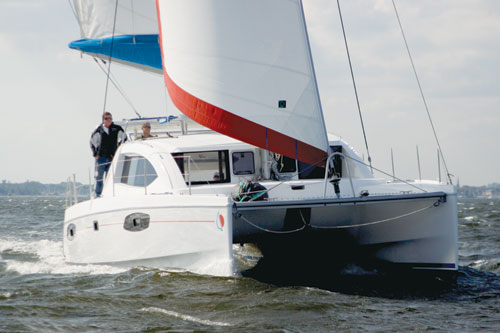
On deck
The cockpit is impressive. It's got plenty of room for roaming but also feels secure if you're headed offshore. There's a table to port for outside dining and clever wraparound seats that face either forward or aft. The robust stainless steel dinghy davits are powered by an electric motor, allowing the dinghy to be hoisted higher than usual and keeping the nice, broad stern open. Most cats have their stern view obstructed by the dinghy davits. Powerboat style mounting platforms trail each hull. This makes coming aboard from the dinghy less of a climb. Secure hatches offer access to the engines and there is also plenty of storage in lockers below the sole. 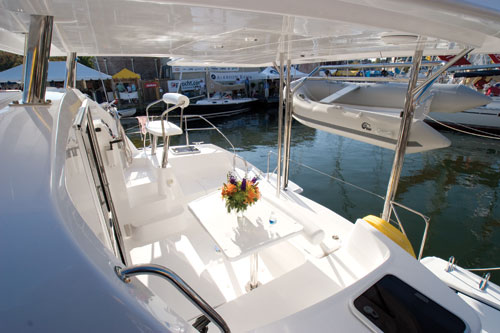
The standard sailplan includes a stack-pack control bag for the full-battened, full-roach main and a fractionally rigged roller-furling jib. The stack pack works very well with full battens, a pulley main halyard and a mainsail track system. This system allows for a powered-up mainsail, a much better alternative to the furling main that's found on too many charter boats. Deck gear is first rate, and in some ways, a bit oversized. I'd like to see a more conventional cleat arrangement with one forward and one amidships, instead of one hefty cleat in between. The anchoring arrangement makes perfect sense. The anchor is launched off the bridgedeck, which provides better structural support than a guide beam running to the stem, and also keeps the boat from swinging and reduces the need for a bridle. It also keeps the forward trampoline area wide open. The tramp material, from Ferrari, is soft and comfortable. 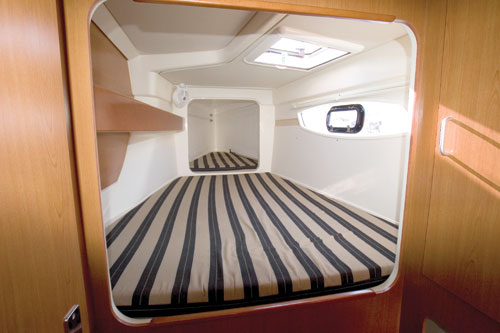
Down below
The Sunsail 384 interior is extremely well thought out. And it needs to be. This may sound silly, but as a midsized cat, the 384 competes with 40-foot boats with a lot more elbowroom. However, the 384 does not give any ground. The first thing you notice when you enter from the cockpit is the headroom, there is plenty of it and it really lends an overall sense of spaciousness. The second thing is the flood of light. The saloon features a large wraparound settee and table. Two large forward-facing opening ports will keep the saloon well ventilated when lying at anchor on a mooring.
The galley is to port and is quite impressive, with ample counter space, a Force 10 stove and oven, and plenty of storage space. The single, aft-facing sink is a bit small but that is a function of the space available. The stainless fridge and freezer compartments are opposite the galley, below the electrical panel. Pull-out drawer style, they are both efficient and user-friendly, much better than the deep caverns on most boats, where the butter disappears beyond reach. 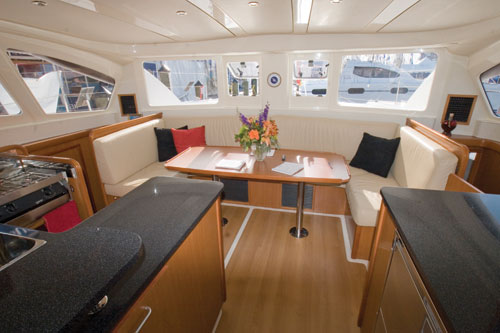
The hull layout is one of the differences between the Sunsail 384 and the Leopard 38 models. Not surprisingly, the 384 features four double cabins, while the Leopard is available in a three-cabin arrangement with a large owner's hull to starboard. The Sunsail 384 has two heads, one in each hull between the cabins, each with a large shower compartment. This is a good use of space; there's no need to cram tiny heads into each cabin.
The aft cabins include fore and aft double berths with opening hatches aft, above and to the sides. These sidelights intrigue me. The opening hatches are set in a larger plastic window, allowing for light and ventilation. The structural aspect of this otherwise practical arrangement made me nervous but I've been assured that it is sound engineering. I like fore-and-aft berths in a boat, even in a non-heeling cat, I just sleep better when I am aligned with the boat's natural motion. The forward cabins also feature double berths, natural light and plenty of ventilation. All the way forward are small peak berths. There's no access from above, which will tend to make them storage areas instead of additional berths, and that's fine. 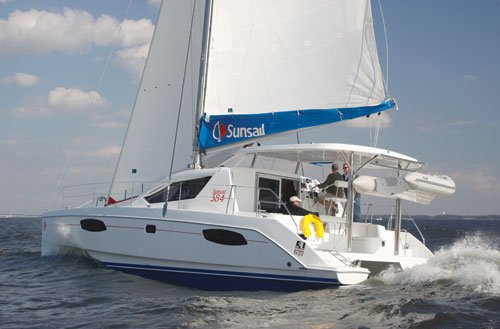
The engines are accessed from exterior hatches aft. I like this arrangement much better than engines located under the aft bunk, which can make the aft cabins unusable when motoring for long stretches. The trade-off is that by positioning the engines well aft they require saildrive transmissions instead of straight shafts. But is this really a trade-off? I don't think so. Two 29-horsepower Yanmar diesels are standard, and two aluminum fuel tanks combine for 92 gallons. And speaking of tankage, the Sunsail 384 water capacity, which includes an extra emergency tank, is impressive-more than 260 gallons. Also, the Sunsail 384 comes standard with two solar panels mounted on the hardtop bimini.
Under sail
The wind was piping up to 30 knots so we finally decided to put a reef in the main. I was impressed with how well the 384 stood up to strong gusty breezes under full sail. Not surprisingly, with a single reef and a tuck in the headsail, we actually sped up. Blasting (and for once the verb is accurate) along on a beam reach we topped 10 knots. The helm required a bit of work, but it should have in those conditions. Falling off onto a deeper reach, we paid out the main and the 384 really found its stride. With a choppy following sea escorting us, we were consistently in double digits. Eleven knots in a 38-foot cruising cat with working sails is very good going indeed. Bringing the boat hard on the wind I was impressed with the 384's ability to sail inside of 50 degrees apparent. 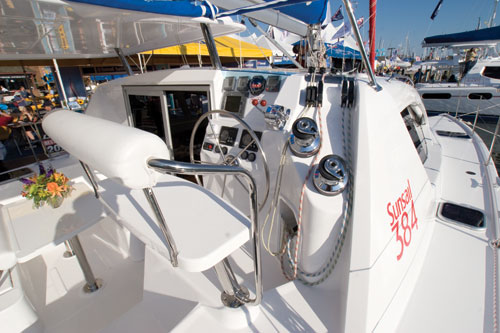
I tried to ignore Grieser's signal that it was time to get going to track down the next boat to test. The sailing was great and I didn't want it to end. Gazing around the bay it was interesting to contrast the 384, zipping along with ease and sailing flat as a pancake, with the precipitously heeled monohulls. The appeal of cruising cats never seemed more obvious. The Sunsail 384 also has an unfair advantage over most other boats. If you're interested in purchasing one, you can easily arrange a week-long test sail, otherwise known as chartering, in an exotic location and make sure that it is the boat for you.
When buying a boat through the Sunsail Yacht Partnership Program owners have 12 weeks to use either their boats or choose to sail other destinations on different boats. The rest of the year, Sunsail puts the boat into charter and sends the owner a guaranteed payment each month that covers the monthly boat payment. All operating, insurance, dockage and maintenance fees are covered by Sunsail. The $349,000 price when buying a boat through the program includes upgrades such as shorepower, air-conditioning, upgraded electronics, solar panels, delivery and everything to make the boat charter ready such as silverware and bedding. The Sunsail 384 is also available without the charter management program as a three-cabin, owner's version Leopard 38.
Sunsail 384
LOA 37'6"; LWL 36'; Beam 19'9"
Draft 3'5"; Displacement 19,790 lbs.
Sail Area 990 sq. ft.
Charter-program Price $349,000
Sunsail Yacht Sales
(800) 817-0807
www.sunsailyachtsales.com
Leopard Catamarans USA
(877) 795-4389
www.leopardcatamarans.com

Comments